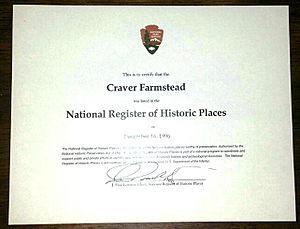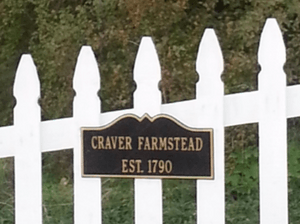Craver Farmstead facts for kids
Quick facts for kids |
|
|
Craver Farmstead
|
|

Craver Farmstead 2014 (225th Anniversary)
|
|
| Location | 115 Craver Rd., East Greenbush, New York |
|---|---|
| Area | 40 acres (16 ha) |
| Built | 1790 |
| Architectural style | Federal |
| NRHP reference No. | 96001423 |
| Added to NRHP | December 16, 1996 |
The Craver Farmstead is a historic farm located in East Greenbush, New York. It was first started around 1790. Back then, it was a large property with 225 acres, a farmhouse, and a barn.
Today, the Craver Farmstead is important for its history and its unique building style. The farmhouse is one of the oldest and best-kept examples of the Federal style in upstate New York. This style was popular in America between 1780 and 1830. It showed that the new United States wanted to be independent in art and architecture, just like it was in politics.
The farmstead sits on Craver Road in Rensselaer County, New York. This road was once just a horse trail leading to the farmhouse. Later, it became a private road for the Craver family. The barn was originally a stable for horses and carriages.
Historically, the Craver Farmstead shows us what farming life was like in New York during the 1700s and 1800s. It helps us remember the hard-working people who settled this area. The Craver Farmstead is officially listed on the National Register of Historic Places. This means it's recognized as a special historical site by the U.S. government.
Contents
The Craver Farmhouse
The Craver farmhouse is a great example of the Federal style. It also shows us what kind of homes farmers in upstate New York lived in for many generations. The house still looks much like it did long ago.
Federal Style Details
The Federal style is known for being balanced and symmetrical. It looks light, elegant, and delicate. The Craver farmhouse still has most of its original windows and parts. It has five sections across the front with a door in the middle.
This two-story house is made of wood with cedar siding. The front door has a gabled porch with a vaulted ceiling. The windows on either side of the door have three tall glass panes. All the doors and windows are perfectly symmetrical. The front windows have 12 panes on the top and 12 on the bottom. They also have their original shutter mounts.
Inside the Farmhouse
Inside, the Craver farmhouse has beautiful decorations. There's a hand-carved wooden fireplace mantel with Federal details. Many rooms have board and batten doors with old iron hardware.
An open staircase leads to the upstairs. The upper level still has its original wide pine plank floors. The walls throughout the house are mostly plaster.
Farmhouse Location
The farmhouse faces south. It has a small, hand-dug basement with a bedrock floor. The house stands on a stone foundation with original hand-cut beams. It is on the north side of Craver Road. To the west is a small pond, and to the east is an apple orchard. A large, old barn is located to the south. An old stone fence marks the northern edge of the property.
There are also old stone foundations nearby. One is about 100 feet east of the barn. Another is next to the farmhouse on its north side. People think this might have been where the kitchen was, separate from the main house.
The Barn and Stable
The barn at Craver Farmstead has its original slate roof. It was built with heavy, hand-cut wood beams. This style is typical of English barns from that time. It has large wagon doors in the center and horizontal wooden siding.
The barn's long side is parallel to a hill. It looks strong and simple, with very thick beams. It rests on a stone foundation. The lower part of the barn once held stalls for dairy cows and workhorses. The upper part was likely used to store hay.
Agricultural Legacy
The Craver Farmstead has rolling farmland and woodlands. Even today, you can find apple trees, asparagus, rhubarb, and climbing roses. These plants are believed to be from plantings done by previous owners over 100 to 225 years ago.
The apple orchard at the farmstead still produces three types of apples. Records from 1875 show that the Craver family had hundreds of apple and pear trees. They also grew other crops. The current orchard has about 30 producing trees. It is the only part of the fruit trees planted by the Craver family more than 100 years ago that still exists.
Detailed History of the Farm
Early Days and Leases
The Craver farmhouse was built before 1790. It appears on an old map drawn by Evert Van Alen. He noted that the farm was "under good improvement" with "enough timber." On February 1, 1790, a lease was signed for the 225-acre farm. The owner was Stephen Van Rensselaer, a powerful landowner. The first tenants were Johannes and Henrick Miller.
The lease itself is historically important. Alexander Hamilton, Stephen Van Rensselaer's brother-in-law, helped design these leases. They kept tenants tied to the estate, even though feudalism (a system where tenants were bound to the land) was outlawed in New York in 1782.
Under this lease, the tenant had to pay all taxes. They could only use the land for farming. The landowner kept rights to timber, water, and minerals. He could even enter the property to use these resources. Tenants could not sell the property itself, only the lease. If they sold the lease, Van Rensselaer could take a fourth of the sale price or buy the property himself for three-quarters of the market price. In 1790, the Millers agreed to pay rent each year. This included 24.5 skipples of winter wheat, four fat chickens, and one day of service with a carriage and horses.
By 1797, the original leased land was divided. William and Henry Coon took over the property. The Craver farmstead was on William Coon's part. In 1841, Elizabeth Craver, who had inherited the farm from her late husband, sold her share to her son, John W. Craver. His family would own the farmstead longer than any other.
The Craver Family Years
John W. Craver was born in Rensselaer County in 1801. He lived in the Craver farmhouse his whole life. By 1830, he was married to Catharine, and they had two daughters, Almira and Emily. They grew up on the farm.
In 1855, records show that John W. Craver was 54 years old and the head of a family of six. He was elected as an "Overseer of the Poor" in his town. This job meant helping people in need and making sure freed slaves could care for themselves.
By 1875, Craver was a 74-year-old widower. He farmed 112 acres, with 90 acres being used for crops. He grew hay, oats, rye, corn, and potatoes. He also had 150 apple trees and 100 pear trees, plus strawberries. He raised cattle, horses, poultry, and pigs. The farm produced butter, eggs, pork, and cider.
John W. Craver died in 1888. His son, Albus, took over the farm. In 1896, Albus passed the property to his son, Irwin Craver. Irwin died in 1929 and left the farm to his wife, Cylvie A. Craver. She sold the Craver farmstead in 1942.
In 1996, the Craver Farmstead was officially added to the National Register of Historic Places.





